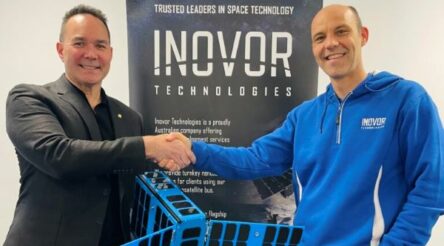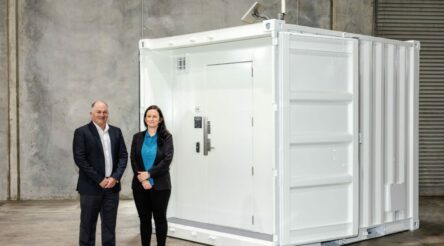Towards 3% R&D – intelligent systems for defence innovation by Saeid Navahandi

Today in our editorial series – Towards 3% R&D – Turbocharging Australia’s Innovation Effort – Saeid Nahavandi looks at the role robotic and autonomous systems can play in defence innovation and operations.
In line with the complexities of modern warfare, the integration of advanced robotic and autonomous systems (RASs), artificial intelligence (AI), and human-machine collaborative technologies has become increasingly critical for Defence organisations to achieve operational preparedness and mission success.
Characterised by the rapid digital advancements and evolving security threats, the transition from Industry 4.0 to Industry 5.0 represents a timely opportunity with significant challenges for Defence organisations to enhance detection and protection capabilities and maintain strategic superiority.
Advancing Human-Machine Synergy
The impending era of Industry 5.0 emphasises the synergy between human wisdom and machine intelligence in task completion and mission accomplishment.
In the dynamic landscape of advanced manufacturing in Defence industry, human-machine collaboration and cooperation present an important factor for achieving enhanced capabilities in various aspects, from production and logistics to intelligence analysis and battlefield support.
In this respect, the development of collaborative robots, or cobots, leads to a paradigm shift in manufacturing processes, where precision, agility, and adaptability are critical.
Equipped with advanced sensing capabilities, autonomous decision-making algorithms, and adaptive learning mechanisms, cobots offer versatility and agility in production operations.
Indeed, from assisting with complex assembly tasks to supporting logistics operations in challenging environments, cobots can enhance operational efficiency and effectiveness across a wide range of domains.
@AuManufacturing is publishing contributions from readers for our series – Towards 3% R&D – turbocharging our national innovation effort – over a, month and in an e-Book, and we urge you to contribute. Call Peter Roberts, 0419 140679 or write to [email protected].
Furthermore, the emergence of robotic and autonomous systems within Defence organisations demands technical expertise and strategic leadership in managing the integration of intelligent Defence technologies.
As a key enabler in Defence operations, RASs play a pivotal role in driving technology adoption, managing risk, and optimising resource allocations for mission planning and achievements.
Moreover, the rise of start-up companies specialising in AI presents new avenues for collaboration and innovation within the Defence industry.
From developing the next-generation unmanned air/land/sea vehicles to utilising AI-based decision support tools, a smart partnership between Defence organisations and start-ups can catalyse innovation and accelerate the pace of technological progress in Defence industry.
Leveraging Human-Centric Decision-Making
The preservation of human insight and expertise in decision-making capabilities remains paramount in the integration of RASs and AI systems in Defence innovation.
By leveraging human wisdom, RASs with a human-in/on-the-loop framework can help Defence organisations to navigate the intricacies of electronic warfare and capitalise on emerging opportunities for technological advancement.
Indeed, human intuition and judgment are indispensable in complex and dynamic operational environments, ranging from mission planning and execution to strategic decision-making in defence resource allocation and force preparedness.
Nevertheless, security, reliability, and interoperability emerge as critical factors in terms of the integration of RASs and AI into defence workflows.
As such, given the sensitive nature of Defence operations and the potential implications of technological vulnerabilities, robust cybersecurity measures and human-centric risk management protocols are essential for safeguarding military assets and capabilities.
On the other hand, environmental sustainability and resource efficiency stand as another key consideration in Industry 5.0.
By leveraging advanced digital technologies in manufacturing practices, Defence industry can minimise their environmental footprint while enhancing operational resilience and sustainability.
These include reducing energy consumption and waste generation to optimising resource utilisation and supply chain management for achieving environmental sustainability.
Summary
The advent of Industry 5.0 accords a transformative opportunity for Defence innovation, offering new avenues for enhancing military capabilities, readiness, and effectiveness.
By embracing the principles of human-machine collaboration and leveraging advanced RASs, AI, and digital technologies, Defence organisations can maintain strategic superiority and address emerging threats in an evolving security landscape.
In short, from enhancing operational efficiency and resilience to fostering collaboration and innovation, it is envisaged that human-centric intelligent systems hold immense potential in the Industry 5.0 era for shaping the future of Defence innovation and ensuring the continued success of Defence organisations in an increasingly complex and contested operational environment.
Distinguished Professor Saeid Nahavandi is Swinburne University of Technology’s inaugural Associate Deputy Vice-Chancellor Research and Chief of Defence Innovation. Saeid Nahavandi received a Ph.D. from Durham University, and his research interests include autonomous systems, modeling of complex systems, robotics and haptics. Saeid was the recipient of the Clunies Ross Entrepreneur of the Year Award 2022, Researcher of the Year for Australian Space Awards 2021, Australian Defence Industry Awards – Winner of Innovator of the year, The Essington Lewis Awards, and Australian Engineering Excellence Awards – Professional Engineer of the Year.
Also today:
Towards 3% R&D – Medical manufacturing to propel the economy by Dig Howitt of Cochlear
This series is brought to you through the support of our principal sponsor, public accounting, tax, consulting and business advisory BDO, and R&D tax incentive consultancy Michael Johnson Associates.
Picture: Saeid Navahandi
Bibliography
European Commission, “Industry 5.0”, 2021. (https://ec.europa.eu/info/research-and-innovation/research- area/industrial-research-and-innovation/industry-50_en)
E. Coronad, T. Kiyokawa, G.A.G. Ricardez, I.G. Ramirez-Alpizar, G. Venture, and N. Yamanobe, “Evaluating Quality in Human-Robot Interaction: A Systematic Search and Classification of Performance and Human-Centered Factors, Measures and Metrics towards an Industry 5.0”, Journal of Manufacturing Systems, vol. 63, pp. 392-410, 2022
J. Barata and I. Kayser, “Industry 5.0 – Past, Present, and Near Future”, Procedia Computer Science, vol. 119, pp. 778-788, 2023
S. Nahavandi, “Industry 5.0-A Human-Centric Solution”, Sustainability, vol. 11(16), Article 4371, 2019
@aumanufacturing Sections
Analysis and Commentary Awards Defence Manufacturing News Podcast Technology Videos











